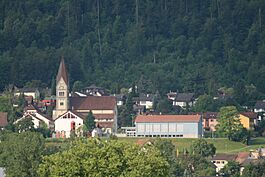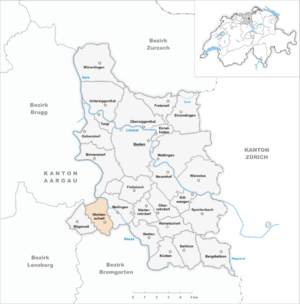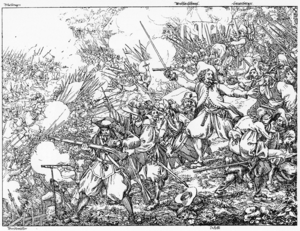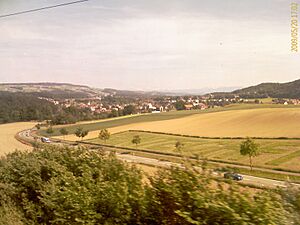Wohlenschwil facts for kids
Quick facts for kids
Wohlenschwil
|
||
|---|---|---|
 |
||
|
||
| Country | Switzerland | |
| Canton | Aargau | |
| District | Baden | |
| Area | ||
| • Total | 4.39 km2 (1.69 sq mi) | |
| Elevation | 374 m (1,227 ft) | |
| Population
(Dec 2020 )
|
||
| • Total | 1,677 | |
| • Density | 382.0/km2 (989.4/sq mi) | |
| Postal code |
5512
|
|
| Surrounded by | Birmenstorf, Birrhard, Hägglingen, Mägenwil, Mellingen, Tägerig | |
Wohlenschwil is a small town, also called a municipality, located in the Aargau canton in Switzerland. It's part of the Baden district. This town is known for its quiet charm and beautiful surroundings.
Contents
History of Wohlenschwil
Wohlenschwil was the location of an important event in Swiss history. On June 3, 1653, the Battle of Wohlenschwil took place here. This battle marked the end of the Swiss peasant war of 1653.
Even though a peace agreement had been signed between the farmers and the city of Bern just days before, another army from Zürich marched towards Aargau. This army, led by Conrad Werdmüller, wanted to stop any remaining resistance.
The Zürich army, with about 8,000 soldiers, took control of the Reuss river crossing at Mellingen. Meanwhile, a large group of about 24,000 farmers gathered in the hills near Wohlenschwil. They tried to talk with Werdmüller, showing him the peace treaty. However, Werdmüller refused to accept it and demanded the farmers surrender.
Because of this, the farmers attacked Werdmüller's troops. But they were not as well-equipped and didn't have cannons. They were defeated in the Battle of Wohlenschwil. After the battle, the farmers had to agree to a new peace deal. The farmer troops went home, and most were forgiven, except for their leaders.
Geography and Landscape
Wohlenschwil covers an area of about 4.4 square kilometers (1.7 square miles). A large part of this land, almost half (47.7%), is used for farming. Forests cover about 35.1% of the area.
Buildings and roads make up 14.7% of the land. The remaining small part (2.5%) includes natural features like rivers or lakes.
Coat of Arms
The coat of arms for Wohlenschwil has a special design. It shows a musket (a type of old gun) and its stand crossed over each other. These are gold and silver in color. Above them, there is a shining golden sun.
Population and People
Wohlenschwil is home to a community of people from different backgrounds. As of the latest information, the town has a population of 1,677 residents. About 14.5% of the people living here are from other countries.
Most people in Wohlenschwil speak German, which is 92.7% of the population. Other languages spoken include Serbo-Croatian (1.1%) and Italian (1.0%).
Age Groups in Wohlenschwil
The population includes people of all ages:
- Children aged 0-9 years old make up about 10.2% of the population.
- Teenagers aged 10-19 years old are about 14.4%.
- Young adults aged 20-29 years old are about 11.9%.
- Adults aged 30-39 years old are about 13.2%.
- Adults aged 40-49 years old are about 17.0%.
- Adults aged 50-59 years old are about 16.3%.
- Seniors aged 60-69 years old are about 9.7%.
- Seniors aged 70-79 years old are about 5.0%.
- People aged 80-89 years old are about 2.1%.
- A very small number, about 0.1%, are 90 years old or older.
Homes and Housing
In Wohlenschwil, there are many different types of homes. Most households have 3 or 4 people living together. The average number of people in each home is about 2.63.
In 2008, more than half of the homes (53.7%) were single-family houses. There were very few empty apartments, meaning most homes were occupied.
Education in Wohlenschwil
Many adults in Wohlenschwil have completed a good level of education. About 77.5% of people aged 25-64 have finished either advanced high school education or gone on to higher education, like a university.
For younger students, in the 2008/2009 school year, there were 96 students attending primary school and 71 students attending secondary school within the municipality.
Economy and Jobs
Wohlenschwil has a low unemployment rate, which means most people who want to work can find jobs. In 2007, the unemployment rate was 1.35%.
The jobs in Wohlenschwil are divided into three main types:
- Primary sector: This includes jobs related to farming and natural resources. About 51 people work in this area.
- Secondary sector: This involves manufacturing and construction. About 67 people work in this sector.
- Tertiary sector: This covers services, like shops, offices, and healthcare. About 128 people work in this sector.
Many people who live in Wohlenschwil travel outside the town for work. About 79.3% of residents work in other places. However, some people also come into Wohlenschwil for their jobs. Most people use a private car to get to work, while some use public transportation.
Religion
Based on a census from 2000, the main religions in Wohlenschwil are:
- Roman Catholic: About 52.0% of the population.
- Swiss Reformed Church (Protestant): About 30.4% of the population.
See also
 In Spanish: Wohlenschwil para niños
In Spanish: Wohlenschwil para niños








